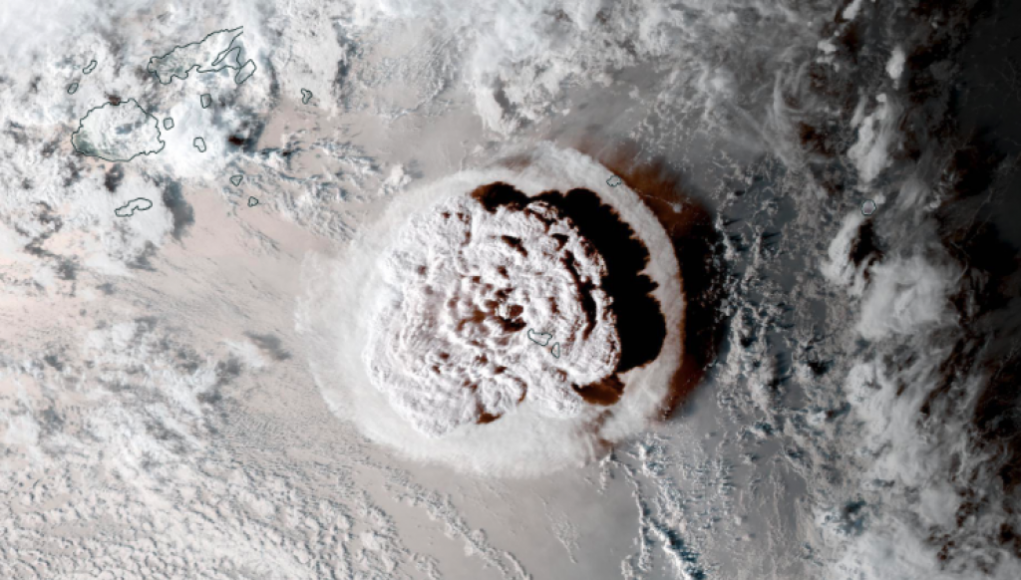Prepare to be amazed by the incredible power of nature. When Tonga’s underwater Hunga Tonga volcano erupted on January 15, 2022, it unleashed a spectacle like no other. The eruption produced an astonishing amount of lightning, setting a new record for the most lightning ever recorded on Earth. Over the course of 11 hours, the volcano lit up the sky with approximately 192,000 lightning flashes, reaching a rate of 2,615 flashes per minute. This mesmerizing display of nature’s fury was captured by a team of researchers led by volcanologist Alexa Van Eaton of the US Geological Survey.
What makes this lightning so extraordinary? Van Eaton and her team discovered that the volcanic plume created its own weather system, sustaining conditions for electrical activity at unprecedented heights and rates. In a study published in Geophysical Research Letters, they explain that the lightning was generated by superfast energetic waves called gravity waves. As these waves passed through the clouds above the volcano, they caused changes in air pressure and turbulence, leading to the formation of lightning.
Advertisement
The eruption of the Hunga volcano unfolded in four distinct phases. Initially, there was no lightning observed as the volcanic plume rose and fell. However, during the second phase, the eruption intensified, propelling magma, water vapor, and other volcanic gases into the stratosphere. This created a massive umbrella cloud, reaching heights of up to 40 km. The upper cloud generated gravity waves, expanding the rings of lightning. The third phase saw a further increase in activity, while the fourth phase marked a gradual decline in intensity.
Although the eruption reached heights above 30 km, making it difficult to detect lightning at times, Van Eaton and her team believe that their findings will contribute to a better understanding of the impact of explosive volcanism on the Earth system. This knowledge will aid in assessing risks to aircraft from lightning and ash clouds, which can impair visibility. The study of this phenomenon is ongoing, as scientists strive to unravel the mysteries of nature’s most spectacular displays.
Get ready to be captivated by the wonders of our planet. This extraordinary event pushes the boundaries of what we thought was possible and reminds us of the awe-inspiring power of nature. As we continue to explore and study these phenomena, we gain a deeper appreciation for the incredible world we live in.
Geophysical Research Letters, 2023. DOI: https://doi.org/10.1029/2022GL102341 (About DOIs).
Elizabeth Rayne is a creature who writes. Her work has appeared on SYFY WIRE, Space.com, Live Science, Grunge, Den of Geek, and Forbidden Futures. When not writing, she is either shapeshifting, drawing, or cosplaying as a character nobody has ever heard of. Follow her on Twitter @quothravenrayne.
Recently, researchers have experienced a truly remarkable event – the first ever recorded case of electrifying volcanic thunderstorms. After a huge eruption of the Taal volcano in the Philippines, a powerful lightning storm of an unprecedented magnitude occurred in the eruption site. This remarkable phenomenon was observed and studied by a team of scientists from the different school departments in the University of the Philippines Diliman.
The eruption took place on 12 January 2020 and was one of the biggest eruptions in the Philippines’ recent history. Right after the eruption – which spewed hot lava and ash hundreds of metres high – loud thunderclaps were observed and huge flashes of lightning in the clouds of the eruption plume visible for dozens of kilometres around the eruption site.
The recorded intensity of the thunderstorm was amazingly high – around 150 lightning strikes per minute. This phenomenon is scientifically referred to as “electrification of volcanic blasts” and is a relatively rare one. Since it was first observed in 1960 at the eruption of the Stromboli Volcano in Italy, only few such events have been recorded.
What triggered this electrifying volcanic thunderstorm is still not known. It is, however, believed that due to the huge heat produced by the eruption, water evaporated intensely, forming the cumulonimbus clouds which in turn resulted in lightning. The lightning seen during such an eruption also tend to be different from usual lightning in that it is more extensive and tends to occur in clusters instead of single flashes.
Although safety concerns prevented any direct measurements of the parameters of this electrifying thunderstorm, the team of scientists managed to gather remarkable images and videos from the Taal eruption. They are now continuing their study in order to further understand the process that causes such an incident and to better understand similar processes during volcanic eruptions that take place in other regions.
In conclusion, the electrifying volcanic thunderstorm that happened during the Taal eruption is a very impressive and unique event that should be studied further. To date, only rare instances of such remarkable phenomena have been observed and documented and much more research is necessary in order to gain a better understanding of the processes responsible for it.




















